2023 Nininger Travel Award recipients announced!
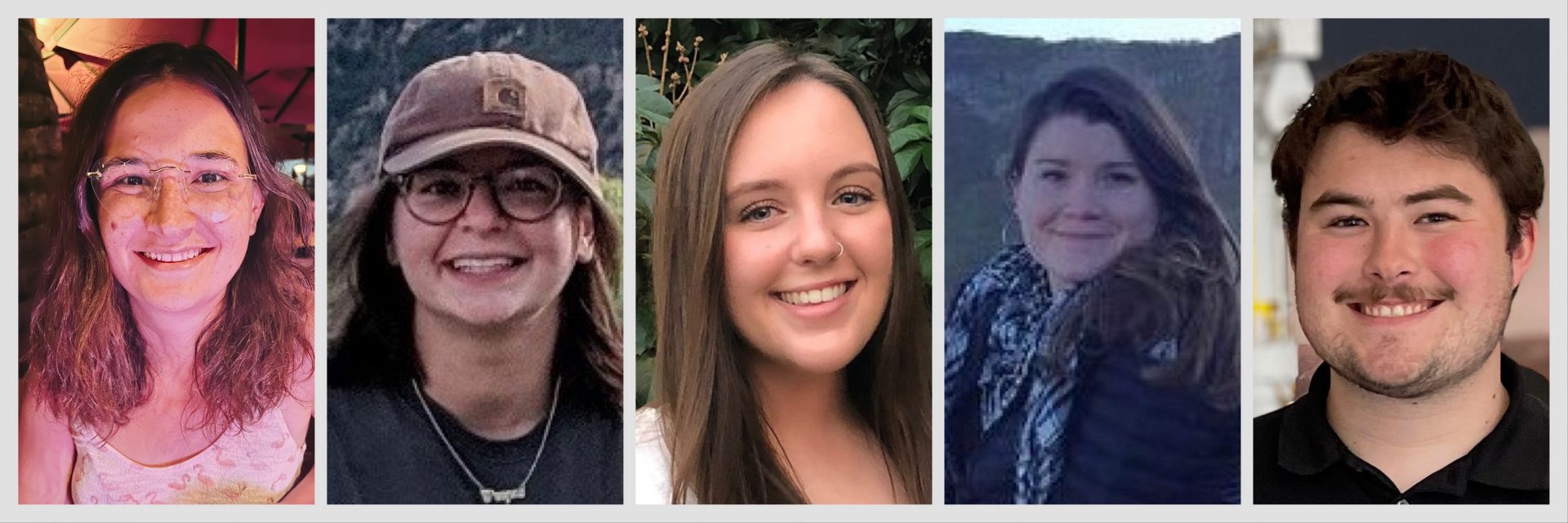
The Buseck Center for Meteorite Studies and School of Earth and Space Exploration are pleased to announce the winners of the 2023 Nininger Student Travel Award. The goal of this award is to support attendance of the annual Lunar and Planetary Science Conference (LPSC) for at least 4 undergraduate and/or graduate students to present their latest research.
The awardees are:
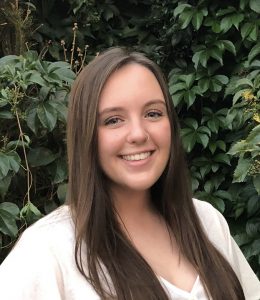 Andrea Distel is a 2nd year PhD student in the School of Earth and Space Exploration working with Drs. Meenakshi Wadhwa, Jemma Davidson, and Richard Hervig. Her research focuses on measuring trace hydrogen in nominally anhydrous minerals (NAMs) in lunar samples in the Secondary Ion Mass Spectrometry (SIMS) lab at ASU. At LPSC, Andrea will present a new data set for the water contents and hydrogen isotopes in pyroxene and olivine for the lunar basaltic breccia meteorite Elephant Moraine (EET) 87521. This research specifically discusses the potential effects of secondary alteration processes that may have affected the D/H ratios in the NAMs of EET 87521, and therefore, has important implications for the lunar volatile community.
Andrea Distel is a 2nd year PhD student in the School of Earth and Space Exploration working with Drs. Meenakshi Wadhwa, Jemma Davidson, and Richard Hervig. Her research focuses on measuring trace hydrogen in nominally anhydrous minerals (NAMs) in lunar samples in the Secondary Ion Mass Spectrometry (SIMS) lab at ASU. At LPSC, Andrea will present a new data set for the water contents and hydrogen isotopes in pyroxene and olivine for the lunar basaltic breccia meteorite Elephant Moraine (EET) 87521. This research specifically discusses the potential effects of secondary alteration processes that may have affected the D/H ratios in the NAMs of EET 87521, and therefore, has important implications for the lunar volatile community.
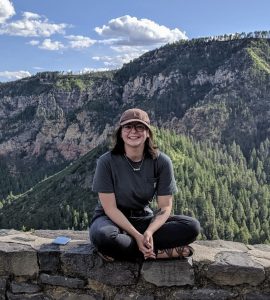 Mara Karageozian is a 5th year PhD candidate in the School of Earth and Space Exploration working with Dr. Tom Sharp. Her primary research investigates how impact processes affect the K-Ar isotopic system in naturally shocked ordinary chondrites. Her work documents an isotopic artifact that results in artificially old impact ages in moderately to heavily shocked meteorites. Without considering this artifact, impact age and the number of impact events may be misinterpreted. At LPSC, Mara will present her results documenting 40Ar/39Ar age artifacts in some of the most ancient L, H, and LL meteorites. She uses these results to discuss best practices for impact age interpretation moving forward. This work was done in collaboration with Mara’s advisor, Dr. Tom Sharp, and Dr. Chris McDonald of the Group 18 Laboratories in SESE.
Mara Karageozian is a 5th year PhD candidate in the School of Earth and Space Exploration working with Dr. Tom Sharp. Her primary research investigates how impact processes affect the K-Ar isotopic system in naturally shocked ordinary chondrites. Her work documents an isotopic artifact that results in artificially old impact ages in moderately to heavily shocked meteorites. Without considering this artifact, impact age and the number of impact events may be misinterpreted. At LPSC, Mara will present her results documenting 40Ar/39Ar age artifacts in some of the most ancient L, H, and LL meteorites. She uses these results to discuss best practices for impact age interpretation moving forward. This work was done in collaboration with Mara’s advisor, Dr. Tom Sharp, and Dr. Chris McDonald of the Group 18 Laboratories in SESE.
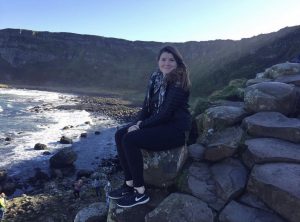 Nicole Phelan is a 2nd year MS student in the School of Earth and Space Exploration working with Dr. Meenakshi Wadhwa in the Isotope Cosmochemistry and Geochronology Laboratory (ICGL). Her research focuses on measuring the Ti isotope compositions of carbonaceous chondrites (CC) using Multicollector-Inductively Coupled Plasma Mass Spectrometry (MC-ICPMS). At LPSC, Nicole will present new measurements of the Ti isotope compositions of the bulk sample of several carbonaceous chondrites. This work seeks to characterize the variability of Ti isotope compositions within the CC group and has implications for the degree of isotopic heterogeneity in the solar nebula, particularly within the CC reservoir.
Nicole Phelan is a 2nd year MS student in the School of Earth and Space Exploration working with Dr. Meenakshi Wadhwa in the Isotope Cosmochemistry and Geochronology Laboratory (ICGL). Her research focuses on measuring the Ti isotope compositions of carbonaceous chondrites (CC) using Multicollector-Inductively Coupled Plasma Mass Spectrometry (MC-ICPMS). At LPSC, Nicole will present new measurements of the Ti isotope compositions of the bulk sample of several carbonaceous chondrites. This work seeks to characterize the variability of Ti isotope compositions within the CC group and has implications for the degree of isotopic heterogeneity in the solar nebula, particularly within the CC reservoir.
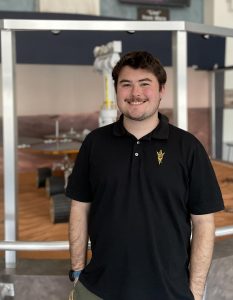 Lucas Reynoso is a 4th-year Barrett undergraduate student majoring in Mechanical Engineering and is interested in understanding the chemistry of ocean worlds. As a NASA Space Grant intern, his current research focus with Dr. Maitrayee Bose is to develop analogs for the dwarf planet Ceres and characterize how organics may be encapsulated and preserved in evaporitic material under Ceres-like conditions. As the most recent Planetary Decadal Survey 2023-2032 proposes several missions to ocean worlds, the work is highly pertinent to furthering our understanding of the probability of organic survival and how this can influence the environmental requirements set for sample collection from ocean world bodies. At the Lunar and Planetary Science Conference, Lucas will present the preliminary results from several analysis techniques that confirm the incorporation of intact amino acid glycine molecules in sodium chloride salt and the resulting change in the pore-size distribution of the salt crystals.
Lucas Reynoso is a 4th-year Barrett undergraduate student majoring in Mechanical Engineering and is interested in understanding the chemistry of ocean worlds. As a NASA Space Grant intern, his current research focus with Dr. Maitrayee Bose is to develop analogs for the dwarf planet Ceres and characterize how organics may be encapsulated and preserved in evaporitic material under Ceres-like conditions. As the most recent Planetary Decadal Survey 2023-2032 proposes several missions to ocean worlds, the work is highly pertinent to furthering our understanding of the probability of organic survival and how this can influence the environmental requirements set for sample collection from ocean world bodies. At the Lunar and Planetary Science Conference, Lucas will present the preliminary results from several analysis techniques that confirm the incorporation of intact amino acid glycine molecules in sodium chloride salt and the resulting change in the pore-size distribution of the salt crystals.
 Leah Shteynman is a PhD student in the School of Earth and Space Exploration working with Professor Tom Sharp. Her research focuses on how impact cratering events affect the structure and chemistry of zircon. Leah’s current work explores how shock metamorphism can change zircon in ways that affect its use as a geochronometer. At LPSC, she will present the first U-Pb SIMS analyses of natural reidite, the high pressure polymorph of zircon formed during impact events. These results will help us more fully understand the zircon-reidite phase transition, which is necessary to accurately assess zircon’s utility in impact dating.
Leah Shteynman is a PhD student in the School of Earth and Space Exploration working with Professor Tom Sharp. Her research focuses on how impact cratering events affect the structure and chemistry of zircon. Leah’s current work explores how shock metamorphism can change zircon in ways that affect its use as a geochronometer. At LPSC, she will present the first U-Pb SIMS analyses of natural reidite, the high pressure polymorph of zircon formed during impact events. These results will help us more fully understand the zircon-reidite phase transition, which is necessary to accurately assess zircon’s utility in impact dating.